DoubleSight DS-277W: Back to the Drawing Board
by Chris Heinonen on June 13, 2012 1:30 AM ESTStraight out of the box and set to 200 nits, the DS-277W offered pretty respectable performance with an average dE of only 6.46. Blues were the main issue, but the grayscale was pretty respectable without calibration, which is the most important aspect with the dE value.

Once calibrated to D65 with 2.2 gamma, the dE drops way down to 1.5 on average. Amazingly this is in line with the more expensive NEC PA271W that I had just tested. The grayscale was nice and flat, and the only colors with an error over 3 were those shades of blue we always see having issues. So despite those huge issues with the brightness level, if you keep yourself at a happy medium light output level, you can get good color results out of the DS-277W.
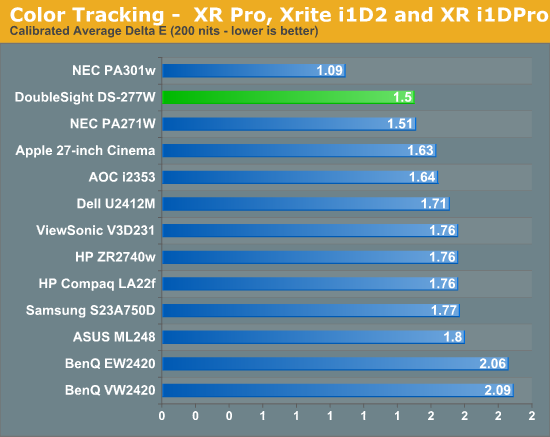
Median color error for 200 nits was the second-best that we have seen. Half of the colors have an error of 1 or less, rendering the difference totally invisible the eye, and a few poor colors are dragging the average way down. If you know what colors are causing this, this can be good as the grayscale and other colors will be accurate, you just need to know that blues will be more incorrect than other shades.

As mentioned on the brightness page, the lowest output level was 140 nits, which means the LUTs have to be adjusted down for reaching 100 nits of light output. This can be done, but shifting the levels to such a large degree can also lead to posterization, a lack of full dynamic range, and other issues with your output, and this is now video card dependant. Possibly because of this the 100 nits average dE rises up to over 2.0 from the 1.5 at 200 nits. Of course since this display only goes down to 140 nits, I would not recommend it for print work either, regardless of the dE value here.
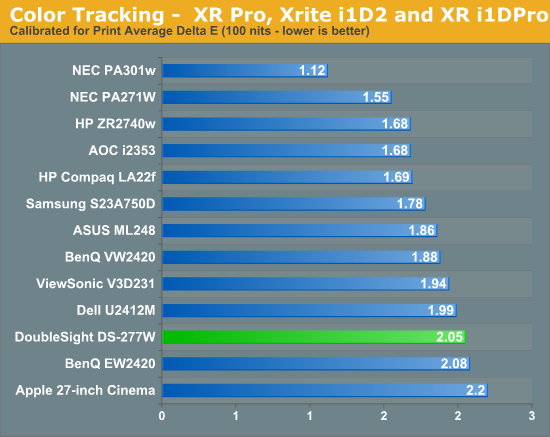
However, it does have a panel and backlighting system with a full AdobeRGB colorspace, and can display over 107% of the AdobeRGB standard. For editing images at 200 nits or so this will work well.
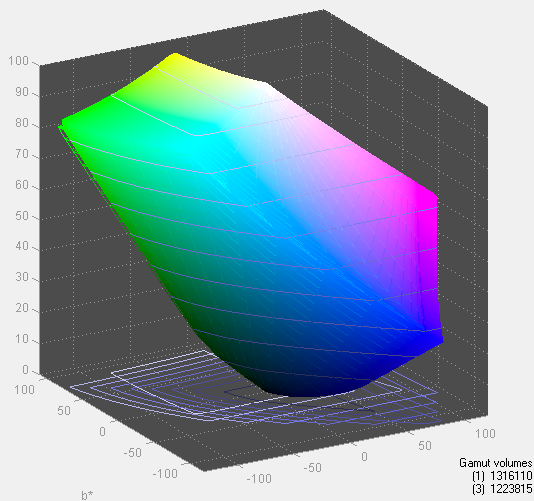
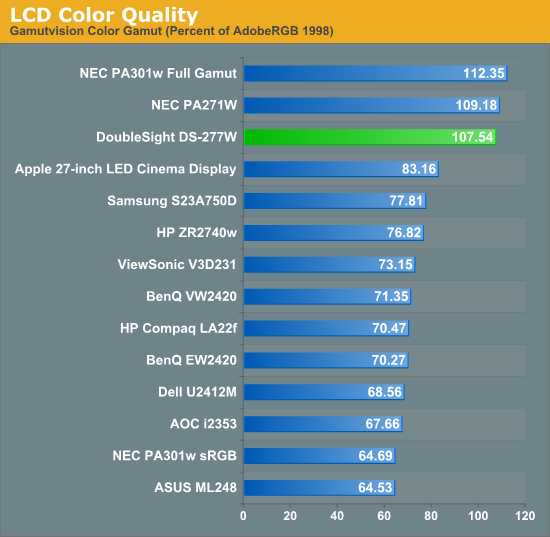


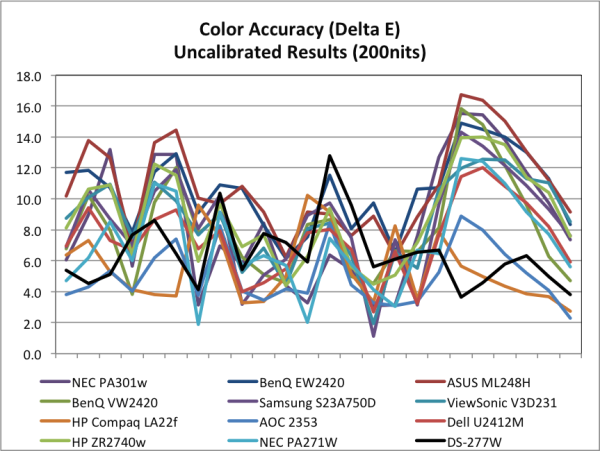
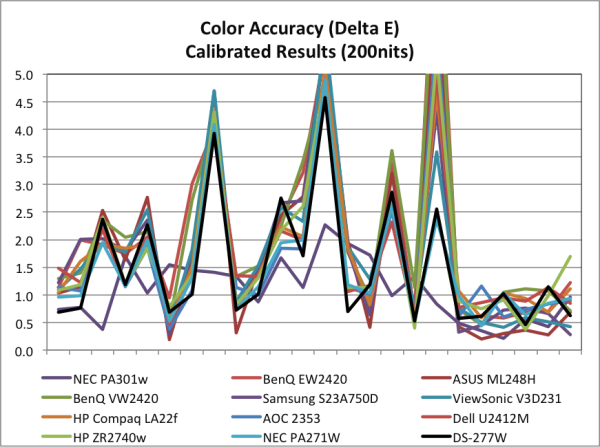
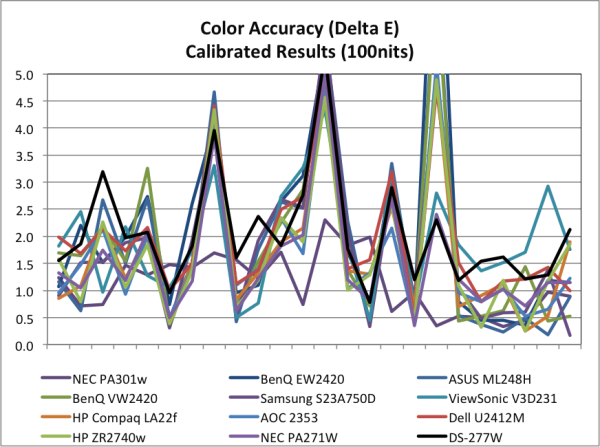








55 Comments
View All Comments
Gunbuster - Wednesday, June 13, 2012 - link
Why would anyone buy an off brand monitor with a meager 1 year warranty for $950?When are they going to figure out there is a group of people that want once step above the catleap. US warranty and a 50% less fugly bezel and stand. for around $450
p05esto - Wednesday, June 13, 2012 - link
How come no large, IPS monitors use LED backlighting? I've been waiting and waiting for this feature. My office gets HOT and I'm trying to convert all lighting to LED and things that don't get so hot. My monitor is the last hot-box that needs to be replaced. For my work I require a large and high quality display, IPS.cheinonen - Wednesday, June 13, 2012 - link
The HP ZR2740w uses LED backlighting and is a 27", 2560x1440 monitor. Lots of the 27" and 30", higher resolution monitors are aimed towards graphics designers and other that are after the AdobeRGB color gamut, and I believe that in the configurations that LG offers the panels in you have your choice of LEDs with sRGB coverage or CCFLs with AdobeRGB coverage. Since people needing AdobeRGB are their target, that is much of the reason for using CCFL over LED I imagine.There might be other 27" or 30" models that use LEDs (Apple Cinema Display is one as well I believe), but I don't know them off hand.
Oxford Guy - Thursday, June 14, 2012 - link
That HP also has a constant control backlight instead of a PWM backlight so there is no flicker.I've been waiting for Anandtech to mention this in reviews. Some monitors have especially bad flicker, especially at lower brightness levels, because of the way they implement PWM.
vol7ron - Wednesday, June 13, 2012 - link
"there was nowhere to put an internal power supply"Do you really do that?
It seems to me that these nice SmartTVs have all the hookups that computers need and the resolution is *starting* to match. With how thin they've gotten, it's questionable how monitor companies are going to continue their lines.
Origin64 - Thursday, June 14, 2012 - link
Why do we need Displayat all? There's nothing it can do that Dual-link DVI can't, as far as I know. It can steer my 1920*1080 120Hz monitor just fine.I don't get why everyone needs a new connector every five years. I know why VGA isn't up to todays standards, and I can see why one could want Thunderbolt (daisychaining isn't possible with DVI) even though I prefer to hook everything up directly. But DP is just another useless standard I don't want or need, just like HDMI. Don't want it, don't need it.
cheinonen - Thursday, June 14, 2012 - link
DisplayPort can drive multiple displays using a hub/repeater (if these are even available yet), use a much smaller cable over longer distances than DVI, carry audio as well as USB signals, has no royalty for VESA members (unlike HDMI which has a royalty still I believe), and is better suited for notebooks.DVI still works fine for most people, but as fewer people need analog support (one main advantage of DVI over DP) I'd expect to see DVI be replaced by DP for the reasons mentioned above. It's pretty hard to stick a DVI adapter onto a laptop at this point compared to MiniDP.
Zoomer - Saturday, June 16, 2012 - link
It gets rid of the TMDS, which is getting problematic in silicon. Further, DL-DVI pretty much maxes out at 25601600 @ 60 Hz. There needs to be something that supports a higher res and/or higher refresh.AdamK47 - Saturday, June 16, 2012 - link
The conclusion states: "there was no way to adjust the backlight that I could find"Did you go into the MISC menu and set ECO to 100? That gives full backlight brightness.
jigglywiggly - Wednesday, June 27, 2012 - link
review that catleap monitor ;x